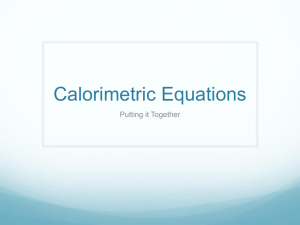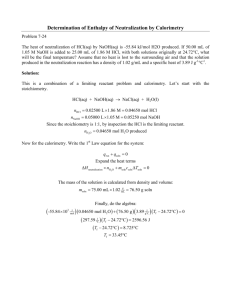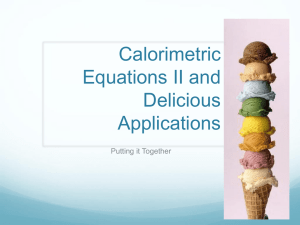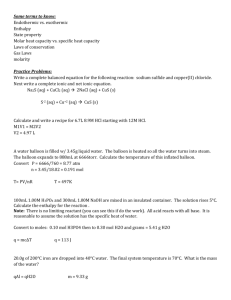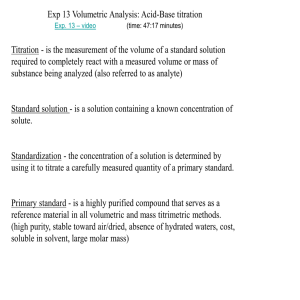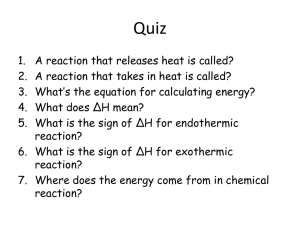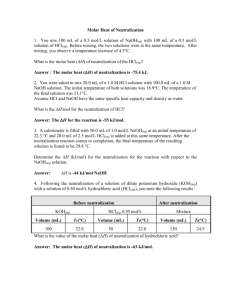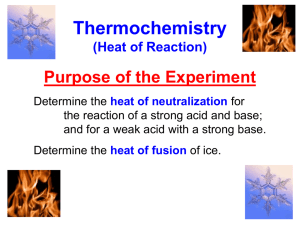12Chem Lesson Plan Calorimetry I
advertisement
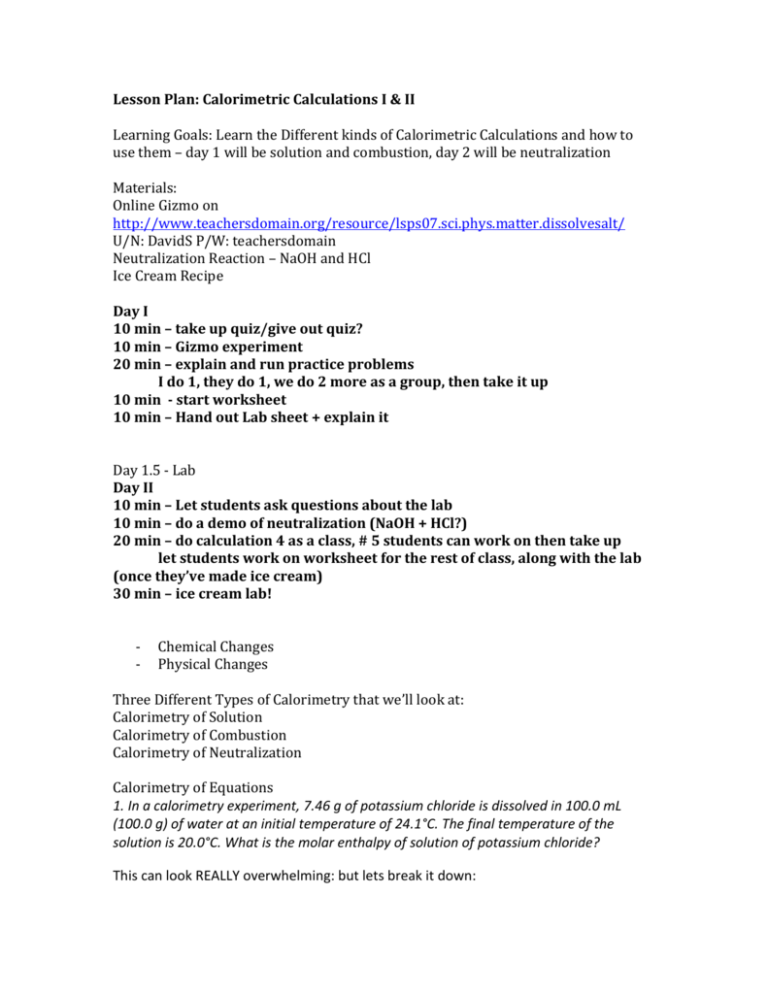
Lesson Plan: Calorimetric Calculations I & II Learning Goals: Learn the Different kinds of Calorimetric Calculations and how to use them – day 1 will be solution and combustion, day 2 will be neutralization Materials: Online Gizmo on http://www.teachersdomain.org/resource/lsps07.sci.phys.matter.dissolvesalt/ U/N: DavidS P/W: teachersdomain Neutralization Reaction – NaOH and HCl Ice Cream Recipe Day I 10 min – take up quiz/give out quiz? 10 min – Gizmo experiment 20 min – explain and run practice problems I do 1, they do 1, we do 2 more as a group, then take it up 10 min - start worksheet 10 min – Hand out Lab sheet + explain it Day 1.5 - Lab Day II 10 min – Let students ask questions about the lab 10 min – do a demo of neutralization (NaOH + HCl?) 20 min – do calculation 4 as a class, # 5 students can work on then take up let students work on worksheet for the rest of class, along with the lab (once they’ve made ice cream) 30 min – ice cream lab! - Chemical Changes Physical Changes Three Different Types of Calorimetry that we’ll look at: Calorimetry of Solution Calorimetry of Combustion Calorimetry of Neutralization Calorimetry of Equations 1. In a calorimetry experiment, 7.46 g of potassium chloride is dissolved in 100.0 mL (100.0 g) of water at an initial temperature of 24.1°C. The final temperature of the solution is 20.0°C. What is the molar enthalpy of solution of potassium chloride? This can look REALLY overwhelming: but lets break it down: We need: Molar enthalpy of solution We have: Mass: 7.46g KCl 100.0g H2O Ti = 24.1oC Tf = 20.0oC deltaT = 4.1oC Hidden numbers: SHC of H20 is 4.184J/gC MM of KCl is (39.10+35.45 = 74.6g/mol) It’s CALORIMETRY so we need to look at our law of Conservation of Energy. ΔH system = +/- qsurroundings Both the water and reactants are in the same system, although if we are drawing an energy flow diagram, we see the energy flow from the water to the reactants, but imagine that outside of the water, there is a barrier to energy and mass flow. Remember, if the reaction couldn’t take the E from water and couldn’t get it somewhere from within itself, the rxn couldn’t occur because it needs E Here is a difficult step. Realize that the enthalpy of KCl dissolving is equal to the heat absorbed or released by the water of the calorimeter. nΔHsol = mcΔT remember: the moles on the left side are of the solute, the mass, SHC, and temp change on the right are of the solvent – assume that the dilute solution behaves like pure solvent REARRANGE ΔHsol = mcΔT /n We know that we want MOLAR enthalpy so lets see how many MOLES of KCl we have: a. 7.46g/74.6g/mol = 0.100mol b. we have the mass of water, we have the c of water, and we have the temp change do the math =17000J/mol or 17KJ/mol express it as an enthalpy change: ΔHsol = +17KJ/mol 2. What mass of lithium chloride must have dissolved if the temperature of 200.0 g of water increased by 6.0°C? The molar enthalpy of solution of lithium chloride is -37 kJ/mol. Find: mass (LiCl) = ? Given: m(water) = 200.0g DeltaT = 6.0oC ΔHsol = 37kj/mol C(water) = 4.184J/gC MM(LiCl)= 42.4g/mol We know that ΔH = qwater LiCl – energy released while dissolving = q absorbed by water nΔHsol = mcΔT ΔHsol = mcΔT /n n(Cl) = 0.14mol n=m/MM m = nMM = 0.14mol x 42.4g/mol m = 5.7g 3. If the molar enthalpy of combustion of propane is -2220KJ/mol, what mass of propane will have to be burned in order to raise the temperature of 1.00L of water from 50.0 to 85°C. Need: mass (propane) Have: ∆(T) = 35°C Hcomb = -2220KJ/mol Mwater = 1000g MMpropane = (36+8) = 44g/mol nΔHcomb = mcΔT n = mcΔT / ΔHcomb m=n x MM 29.0g http://www.chm.davidson.edu/vce/calorimetry/HeatOfCombustionofMethane.htm l 4. A calorimeter (C=0.850J/˚C) containing 5.00 x 102 ml of water at 22 oC is warmed to 100oC when 9.00 g of cheddar cheese is burned. Calculate the heat absorbed by the water and the heat of combustion, per gram, of cheese. For class II Day II 10 min – Let students ask questions about the lab 10 min – do a demo of neutralization (NaOH + HCl?) 20 min – do calculation 4 as a class, # 5 students can work on then take up let students work on worksheet for the rest of class, along with the lab (once they’ve made ice cream) 30 min – ice cream lab! Calorimetry of Neutralization 4. A chemist wanted to find the heat of neutralization of HCl with NaOH. She added 61.1ml of 0.543mol/L HCl to 42.6ml of 0.779mol/L NaOH. The initial temperature of both solutions was 17.8oC and the highest recorded temperature of the solution after neutralization was 21.6˚C. What is the enthalpy of neutralization of HCl? Assume: The density and heat capacity of the solutions is the same as that for pure water. (total V = 103.7ml = 103.7g) ∆T = 3.8˚C 5. 50.0 mL of 0.300 mol/L CuSO4 solution is mixed with an equal volume of 0.600 mol/L NaOH. The initial temperature of both solutions is 21.4oC. After mixing the solutions in the coffee-cup calorimeter, the highest temperature that is reached is 24.6oC. Determine the enthalpy change of the reaction. CuSO4(aq) + 2NaOH(aq) → Cu(OH)2(s) + Na2SO4(aq) Copper(II) sulfate, CuSO4, reacts with sodium hydroxide, NaOH, in a double displacement reaction. A precipitate of copper(II) hydroxide, Cu(OH)2, and aqueous sodium sulfate, Na2SO4, is produced. Need to find ΔH reaction Volume of CuSO4 solution, VCuSO4 50.0 mL Volume of NaOH solution, VNaOH 50.0 mL Initial temperature, Ti 21.4 ̊C Final temperature, Tf 24.6 ̊C
